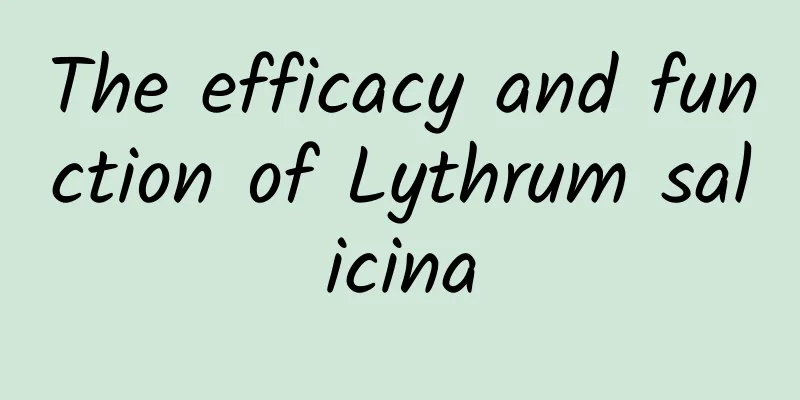What are the taboos of eating Aconitum carmichaelii?

|
Aconitum kusnezoffii is a common Chinese herbal medicine that can be taken orally or applied externally. Whether it is taken orally or applied externally, the effect is very good. However, improper use of Aconitum kusnezoffii can easily cause poisoning. When using Aconitum kusnezoffii, you must consult a doctor or use it under the guidance of a doctor, otherwise it will be harmful to your health. So what are the taboos of eating Aconitum kusnezoffii? The efficacy, effects and contraindications of Aconitum kusnezoffii In fact, Aconitum carmichaelii is a kind of Chinese herbal medicine. It can be taken orally or used externally. It has many benefits, but also many contraindications. It can regulate and improve the symptoms of cold body, and it can also relieve joint problems. Let’s take a look at its specific effects and functions. Effect of dispelling wind and dampness Caowu is pungent, hot, bitter and dry. It is good at expelling cold and dampness, warming the meridians and relieving pain. It is an excellent product for treating arthralgia caused by cold and dampness, and is especially suitable for arthralgia caused by the predominance of cold evil. It can treat symptoms such as cold and dampness invasion, joint pain, and inability to flex and extend. It can also treat cold and dampness blood stasis in the meridians, spasm and pain in the tendons and veins of the limbs, and difficulty in flexing and extending the joints, which do not heal over time. Warming the meridians, dispelling cold and relieving pain Caowu has a pungent, warming and unblocking effect, and its effects of dispelling cold and relieving pain are particularly obvious. Therefore, it is often used to treat symptoms such as cold pain in the heart and abdomen caused by internal accumulation of yin and cold. For example, it can be used to treat heart pain that goes through the back, back pain that goes through the heart, as well as cold hernia, abdominal pain around the navel, cold hands and feet, and other symptoms. Pain relief Aconitum has a strong analgesic effect and can be used to treat trauma, injuries, fractures, blood stasis and pain. It can also be used as an anesthetic analgesic. Adverse reactions of Aconitum At that time, some people still need to be careful, because not everyone is suitable for eating Aconitum kusnezoffii. Once it is accidentally eaten, a series of adverse reactions may occur, and severe ones may threaten life. Improper use of Aconitum can cause poisoning, the symptoms of which include numbness of the mouth, tongue, limbs and whole body, salivation, nausea, vomiting, diarrhea, dizziness, blurred vision, dry mouth, slow pulse, difficulty breathing, convulsions of hands and feet, confusion, incontinence, decreased blood pressure and body temperature, heart rate disorders, premature ventricular contractions and sinoatrial arrest, etc. In severe cases, it can lead to circulatory failure, respiratory failure and severe cardiac arrhythmia and death. Taboos of Aconitum Although Aconitum carmichaelii is a traditional Chinese medicinal material, it is not suitable for everyone to eat. Therefore, before eating it, you must know whether you can eat it. If you can eat it, you must understand its contraindications to prevent any problems. 1. Avoid cooking for too short a time Long-term decoction of Aconitum or the recently adopted high-pressure steaming can reduce its toxicity. If the condition requires increasing the dosage of Aconitum, it is better to decoct it for a longer time. Decoction time that is too short can easily lead to poisoning. Aconitum should never be used raw. 2. Avoid unprocessed food Aconitum is highly toxic, so it must be processed before it can be taken internally. The prescription for internal use should also state processed Aconitum, processed Chuanwu, or processed Caowu. If taken without being processed, even a small amount can cause poisoning. 3. Avoid taking Aconitum kusnezoffii for a long time Long-term use of Aconitum can accumulate in the body and cause poisoning, especially in patients with liver and kidney dysfunction. If the condition requires long-term use of preparations containing Aconitum, intermittent medication can be used. After taking it for a few days or weeks, take a break for 1 week. In addition, you can take the medicine in small amounts and multiple times a day, dividing the total daily amount into several doses to facilitate the excretion of toxins. |
<<: What are the symptoms of Aconitum poisoning?
>>: How to cure Aconitum poisoning?
Recommend
The efficacy and function of Tuliangjiang
Alpinia ulmoides is a kind of traditional Chinese...
The efficacy and function of red orchid
Red Gate Orchid is something that many people are...
Can Panax notoginseng powder be taken for a long time?
Panax notoginseng powder is a common health-care ...
What are the effects of Astragalus extract?
The main ingredient of Astragalus essence is Astr...
The protagonist of global warming is melting, do you really understand it?
When it comes to glaciers, perhaps the only thing...
Why do you always smell after eating hot pot? Is it related to nitrite? Here comes the truth...
This article was reviewed by Liu Shaowei, food sa...
The efficacy and function of frankincense
Medicine is something we cannot live without in o...
Is liposuction really safe? You will understand after reading this!
Do you know where the term “sterile operating roo...
The efficacy and function of geranium
Traditional Chinese medicine often has unexpected...
The driving force behind Jupiter's continued "fever" has been found, it turns out to be this!
According to our common understanding, the closer...
Counting: Ancient Chinese Mathematical Wisdom on Small Sticks
The numbers that seem simple to modern people are...
Black workers: 90s bees cloned into a million-strong army, almost subverting the South African beekeeping industry
More, more, more. Written by | Krestrel Honey bee...
Go to 331 and cross the northern border of China!
In northern China A total length of more than 9,0...
How did carambola become the "most unpalatable" fruit in the world?
If some fruits win popularity with their taste, t...









